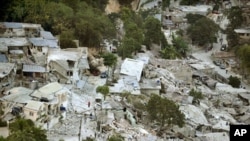The United Nations Environment Program warns Haiti's recovery process will be greatly constrained if the environmental degradation suffered during the catastrophic earthquake is not adequately taken care of. UNEP says cleaning up Haiti's environmental mess will be long, difficult, and expensive.
The program says Haiti was the poorest and most environmentally degraded country in the Caribbean before the earthquake struck in mid-January.
It says Haiti's rural environment was largely destroyed, making it difficult to fully feed its population. It says the damaged water collecting devices made the country vulnerable to flooding and other natural disasters. It says there is extensive soil erosion in Haiti and only three percent of the country's original forest cover is left.
UNEP Program Manager for Haiti, Andrew Morton, says the earthquake has brought with it a great many new environmental problems. "Well, as you all know, there are literally millions of tons of debris from fallen buildings, which is not just concrete, but everything that is contained in a building, as you see here - wood, plastic, metal, clothing, everything. We have a major increase in municipal and health care waste. A burst of medical activity means we have probably tripled the volume of health care waste and, of course, as we clean up, the volume of municipal waste goes up. And, I have to say, as the relief effort comes in with its several hundred millions of dollars of aid, it is adding to the waste burden as well."
Morton has been in Haiti since the earthquake hit and he will be going back to the country next week to supervise the work that needs to be done. He describes the challenges ahead as huge.
For instance, he notes, prior to the earthquake health care waste was disposed of by burning or by trucking it to a landfill site. He says it then was torn apart by scavengers who make a living by recycling waste.
"So, what we do not want is for health care waste to go that way. So, what we needed, of course, was some way of separating the waste and also treating it in a hygienic manner. So, the actual practical measures which were put in place, we imported a large number of containers for the segregation of the waste and we looked at buying fuel for the incinerators that are already there, so that they can start up again. That is just a small example of a practical problem and a practical solution," he said.
Morton says a bigger problem for which UNEP has not yet found a solution is transitional shelter. This, he says, is designed to shelter half a million people for up to two years. He says they will be made out of tin and timber.
However, the problem is there is no timber in Haiti. Morton says the solution to this is the bulk importation of timber. But, this is very expensive and will only be possible if the aid community decides to support this project.
UN: Environmental Degradation in Haiti Made Worse by Earthquake









